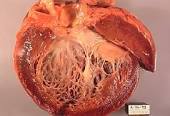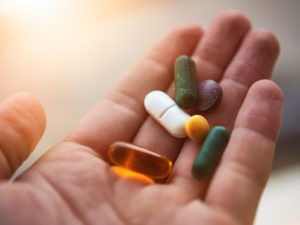
Diagnosed with Cancer? Your two greatest challenges are understanding cancer and understanding possible side effects from chemo and radiation. Knowledge is Power!
Learn about conventional, complementary, and integrative therapies.
Dealing with treatment side effects? Learn about evidence-based therapies to alleviate your symptoms.
Click the orange button to the right to learn more.
- You are here:
- Home »
- Blog »
- side effects ID and prevention »
- Doxorubicin is Cardio-toxic!
Doxorubicin is Cardio-toxic!

There is no other way to say it. The chemotherapy doxorubicin is cardio-toxic. Meaning, if you are a cancer patient undergoing DOX, you will damage your heart.
The damage may show up immediately or not for months or even years. I developed chemotherapy-induced cardiomyopathy fully 15 years AFTER I underwent several different cardiotoxic chemo regimens.
But make no mistake. Dox will damage your heart.
Now, there may be important reasons why your oncologist is prescribing dox for you. Please understand- conventional oncology spends little time and little money to learn about the long-term and late stage side effects of chemotherapy and radiation. I have no problem with this- their job is to treat your cancer.
What are the pros and cons of doxorubicin?
Pros:
- Effectiveness: Doxorubicin is a potent chemotherapy drug used to treat various types of cancer, including breast cancer, leukemia, and lymphoma. It’s often part of combination chemotherapy regimens and can be highly effective in killing cancer cells.
- Versatility: It can be used alone or in combination with other chemotherapy drugs or treatments, providing flexibility in treatment plans.
- Wide application: Doxorubicin has been used for many years and is well-studied, so doctors have a good understanding of its efficacy and side effects across different types of cancer.
- Adjunct to surgery or radiation: It can be used before surgery or radiation to shrink tumors, making them easier to remove or target with radiation.
Cons:
- Side effects: Like most chemotherapy drugs, doxorubicin can cause a range of side effects, including nausea, vomiting, hair loss, fatigue, and increased susceptibility to infections due to lowered white blood cell counts.
- Cardiotoxicity: One of the significant concerns with doxorubicin is its potential to cause heart damage, especially with high cumulative doses. This can lead to conditions like cardiomyopathy and congestive heart failure.
- Risk of secondary cancers: Some patients treated with doxorubicin have an increased risk of developing secondary cancers later in life, although this risk must be weighed against the potential benefits of treatment.
- Treatment resistance: Over time, cancer cells may become resistant to doxorubicin, limiting its effectiveness in some cases.
- Long-term effects: Some side effects, such as heart damage, can manifest months or years after treatment has ended, requiring long-term monitoring and management.
What I do have a hard time with is that conventional oncology ignores the importance of evidence-based non-conventional therapies. According to research linked below, the patient can prevent chemotherapy-induced cardiomyopathy. According to research:
- curcumin
- moderate exercise
- Ajwa
Have you been diagnosed with cancer? What type? What stage? If you’d like to learn more about both conventional and non-conventional therapies to help you manage your cancer send me an email-
David.PeopleBeatingCancer@gmail.com
David Emerson
- Cancer Survivor
- Cancer Coach
- Director PeopleBeatingCancer
Curcumin attenuates doxorubicin-induced cardiotoxicity via suppressing oxidative Stress, preventing inflammation and apoptosis: Ultrastructural and computational approaches
“Currently, doxorubicin (DOX) is one of the medications commonly used in chemotherapy to treat different types of tumors.Nonetheless, despite being effective in multiple tumors, yet its use is limited owing to its cytotoxic effects, the therapeutic use of DOX has been limited. This work aimed to explore whether curcumin (CMN) can prevents DOX-induced cardiotoxicity in rats…
Increased, AST, and ALT serum levels, increased MDA levels, decreased SOD and CAT levels, and increased TNF-α concentrations in heart homogenates were all signs of DOX-induced myocardial injury.
Histological and ultrastructural examinations revealed vacuoles and larger, swollen mitochondria in the cytoplasm. Furthermore, DOX caused significant changes in the myocardium, most notably nuclei disintegration, myofibrillar loss, and myocyte vacuolization.
Using CMN with DOX reduced the harmful consequences of DOX on the myocardium by returning the increased AST and ALT levels to their original levels as compared to the control and reducing them…”
Doxorubicin-Induced Cardiotoxicity: An Overview on Pre-clinical Therapeutic Approaches
“Doxorubicin is an effective chemotherapeutic agent prescribed to treat solid tumors (e.g., ovary, breast, and gastrointestinal cancers). This anti-cancer drug has various side effects, such as allergic reactions, cardiac damage, hair loss, bone marrow suppression, vomiting, and bladder irritation.
The most dangerous side effect of doxorubicin is cardiomyopathy, leading to congestive heart failure. The exact mechanisms of doxorubicin-induced cardiotoxicity remain incompletely understood. Alteration in myocardial structure and functional cardiac disorders is provoked by doxorubicin administration; subsequently, cardiomyopathy and congestive heart failure can occur.
Congestive heart failure due to doxorubicin is associated with mortality and morbidity. Probably, doxorubicin-induced cardiotoxicity starts from myocardial cell injury and is followed by left ventricular dysfunction.
Many factors and multiple pathways are responsible for the creation of doxorubicin-induced cardiotoxicity. Inflammatory cytokines, oxidative stress pathways, mitochondrial damage, intracellular Ca2+ overload, iron-free radical production, DNA, and myocyte membrane injuries have critical roles in the pathophysiology of doxorubicin-induced cardiotoxicity.
Unfortunately, there are currently a few medications for the treatment of doxorubicin-induced cardiotoxicity in clinical settings…”
Ajwa Nanopreparation Prevents Doxorubicin-Associated Cardiac Dysfunction: Effect on Cardiac Ischemia and Antioxidant Capacity
“Background: This study evaluated the cardioprotective effect of Ajwa nano-preparation against doxorubicin-associated cardiotoxicity.
Methods: Twenty-four male Wistar rats (200-250 g) were divided into 3 groups. One group was given the nanopreparation containing both Ajwa fruit and pit in a dose of 1.4 g/kg orally 1 hour before doxorubicin infusion (Dates-DOX group). Another group was given the vehicle for 1 hour before doxorubicin infusion (DOX group). The third group received the vehicle but no DOX infusion (time control). Cardiac hemodynamics, blood pressure, cardiac contractility, and conductivity were recorded before and after 45 minutes of infusion of doxorubicin (15 mg/kg, slow intravenous over 45 minutes). Blood samples were collected before and after doxorubicin infusion. Heart tissue samples were collected and snap frozen until assay of reduced glutathione.
Results: Rats pre-administered Ajwa nanopreparation were protected from doxorubicin-associated systolic and diastolic dysfunction based on the significant elevation in the rate of rise in left ventricular pressure (dp/dtmax) and (dp/dtmin) compared with the DOX group. In addition, it prevented the doxorubicin-associated ischemia based on the significant shortening in QT interval, JT interval, and Tpeak–Tend interval versus the DOX group. There was no effect on atrial conductivity (PR interval and P duration). Ajwa pretreatment increased the antioxidant capacity of cardiac tissue, as evidenced by increasing the cardiac content of reduced glutathione compared with the untreated doxorubicin group.
Conclusion:Ajwa nanopreparation protects from doxorubicin-associated cardiotoxicity through alleviating cardiac ischemia and increasing cardiac antioxidant capacity…


